List of Contents
Sleep Tech Devices Market Size and Forecast 2025 to 2034
The global sleep tech devices market size was estimated at USD 24.85 billion in 2024 and is predicted to increase from USD 29.30 billion in 2025 to approximately USD 134.60 billion by 2034, expanding at a CAGR of 18.46% from 2025 to 2034.
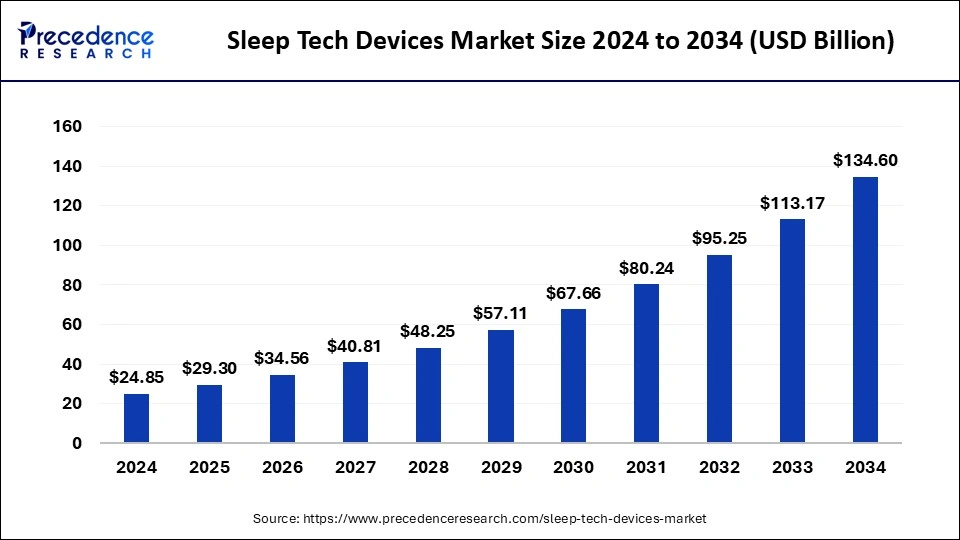
Sleep Tech Devices Market Key Takeaways
- In terms of revenue, the global sleep tech devices market was valued at USD 24.85 billion in 2024.
- It is projected to reach USD 134.60 billion by 2034.
- The market is expected to grow at a CAGR of 18.46% from 2025 to 2034.
- North America dominated the global market with the largest market share of 42.6% in 2024.
- By product, the wearables segment held the largest share of around 75.7% in 2024. The segment is observed to sustain the dominance throughout the forecast period.
- By application, the insomnia segment dominated the sleep tech devices market with a revenue share of 47.9% in 2024.
- By distribution channel, the sleep centers and fitness centers segment stood as a dominating share of the market in 2024.
U.S. Sleep Tech Devices Market Size and Growth 2025 to 2034
The U.S. sleep tech devices market size was evaluated at USD 10.15 billion in 2024 and is projected to be worth around USD 52.90 billion by 2034, growing at a CAGR of 18.00%.
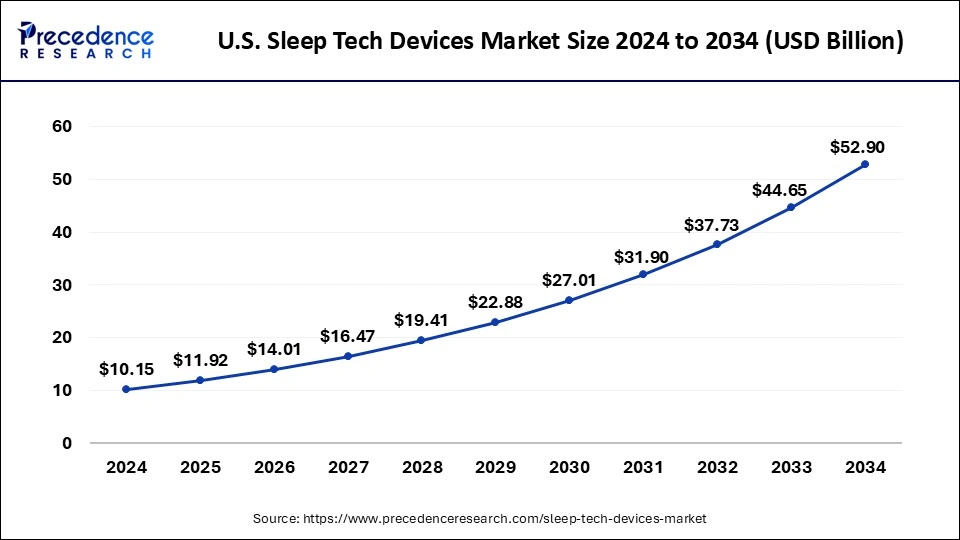
North America led the market with the biggest market share of 42.6% in 2024. The region is observed to sustain the position throughout the forecast period. The regional growth is attributable to growing product releases, the existence of important competitors, rapid technical breakthroughs, and the increased frequency of sleeping disorders. The elderly are more likely to suffer from sleeplessness.
- According to research released by the Sleep Foundation Organization in May 2022, around 35.2% of all people in the United States reported sleeping for fewer than seven hours each night. Similarly, according to November 2021 research issued by the American Academy of Sleep Medicine (AASM), around 75.0% of people aged 65 and more suffer from insomnia symptoms, whereas approximately 20.0% of preteens have insomnia symptoms.
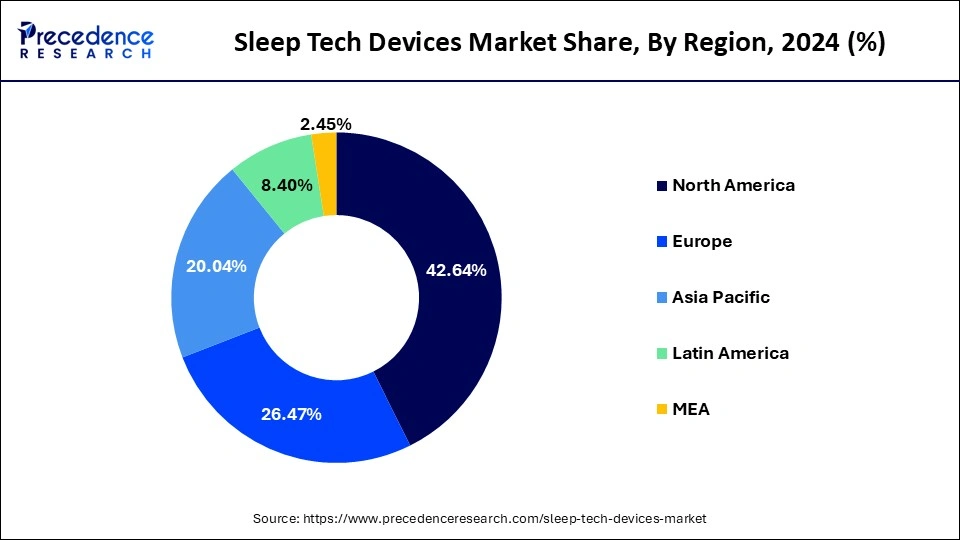
As a result, these variables are expected to have a beneficial influence on the regional market's growth. Some of the reasons propelling the growth of the sleep tech devices market in the United States are the high incidence of sleep disorders, the high concentration of manufacturers or market participants, and the introduction of major new products.
- In May 2022, for instance, the Sleep Foundation Organization published a report that listed the percentage of adults in major U.S. cities who slept for less than seven hours a night. Boulder, Colorado had the lowest rate, at about 24.2%, while Camden, New Jersey, and Detroit, Michigan, had the highest rates, with 49.8% of adults in those cities reporting short sleep. Consequently, during the projected period, the country's extremely high prevalence of sleep disorders is anticipated to propel market expansion.
Market Overview
The sleep tech devices market revolves around the production, innovation and distribution of electronic gadgets that are used to track and enhance sleep for those suffering from insomnia, narcolepsy, and sleep apnea. The market is filled with a wide range of technologically advanced sleep technology products, such as earplugs, headbands, rings, sleep pads, mattresses, and wearable smart watches and bands.
Over the past several years, there have been major advancements in sleep enhancement applications that have completely changed the sleep tech sector. Newly developed sleep technology can regulate temperatures that may otherwise disrupt sleep in addition to recording sleep. The market for sleep technology gadgets will expand favorably as more of these modernized sleep aids become available.
Sleep Tech Devices Market Growth Factors
- Increased awareness of the impact of sleep on overall health and well-being has driven consumer interest in sleep tech devices. People are seeking solutions to monitor and enhance their sleep quality.
- The growing prevalence of sleep disorders, such as insomnia, sleep apnea, and restless leg syndrome, has created a demand for devices that can assist in diagnosing and managing these conditions, while promoting the growth of the sleep tech devices market.
- The popularity of wearable devices, such as smartwatches and fitness trackers, that include sleep tracking features has contributed to the mainstream acceptance of sleep tech. Consumers appreciate the convenience of having sleep monitoring integrated into devices they already use.
- Greater integration of sleep tech devices with healthcare systems and the endorsement of these technologies by healthcare professionals could boost their adoption for diagnostic and therapeutic purposes.
Market Scope
| Report Coverage | Details |
| Growth Rate from 2025 to 2034 | CAGR of 18.46% |
| Market Size in 2025 | USD 29.30 Billion |
| Market Size by 2034 | USD 134.60 Billion |
| Base Year | 2024 |
| Forecast Period | 2025 to 2034 |
| Segments Covered | Product, Application, and Distribution Channel |
| Regions Covered | North America, Europe, Asia-Pacific, Latin America, and Middle East & Africa |
Market Dynamics
Driver
Growing incidence of sleep disorders
Over the projected period, the rising incidence of sleep disorders worldwide is expected to propel market expansion. For instance, the American Sleep Association (ASA) reported in January 2022 that between 50.0 and 70.0 million individuals in the US experience sleep issues annually. Additionally, it stated that between 30 and 40 percent of persons have insomnia symptoms annually at some point in their lives. Additionally, it was stated that one in three persons may experience sleep disturbances at some point in their lives, making them among the most difficult medical diseases. Throughout the forecast period, the increasing frequency of sleep disorders is anticipated to drive up demand for sleep tech devices.
- For instance, in May 2022, According to Sleep Disorders Facts and Statistics, 50–70 million individuals in the US suffer from sleep disorders, and the incidence of these conditions follows a similar trend. Such factors are observed to promote the growth of the sleep tech devices market.
Restraint
Accuracy and privacy concerns
The accuracy of sleep monitoring devices can vary, and some consumers may be skeptical about the reliability of the data provided. Concerns about false readings or misinterpretation of sleep metrics may impact adoption. In addition, sleep tech devices often collect sensitive health data. Privacy concerns regarding the storage, sharing, and potential misuse of this information can deter some individuals from using these devices. Thereby, such accuracy and privacy concerns are observed to create a significant restraint for the sleep tech devices market.
Opportunity
Growing partnership
The growing partnership and other business activities around the industry are expected to offer a lucrative opportunity for the sleep tech devices market during the forecast period. Business activities including partnerships, collaborations or acquisitions offer a set of chances for new product innovation and launches in the market. For instance, in April 2023, LG Electronics and Asleep, a South Korean sleep-tech AI firm that specializes in sleep diagnostics, teamed together to develop next-generation smart home appliances that are tailored and optimized for the unique sleep circumstances of individual customers.
To develop new smart home products that employ Asleep's AI technology to identify sleep phases based on users' breathing noises while they are asleep, the firms signed a memorandum of understanding (MOU) for "sleep research cooperation. Users may monitor the four phases of sleep based on their breathing sounds with Asleep's AI technology by using microphone-equipped devices, such as smartphones and smart TVs. LG intends to incorporate this technology into further appliances, such as washing machines, refrigerators, air conditioners, air purifiers, and TVs.
Product Insights
The wearables segment held the largest market share of 75.7% in 2024. The segment is observed to continue dominance throughout the forecast period. Wearable sleep tech devices offer the advantage of convenience and accessibility. Users can wear these devices throughout the day and night, providing continuous monitoring without the need for additional equipment.
Additionally, wearables often offer a holistic approach to health tracking by combining sleep data with other metrics like physical activity, heart rate, and stress levels. This integrated approach provides users with a comprehensive overview of their well-being. Furthermore, the growing product launches in wearables sleep devices are expected to drive the segment expansion. For instance, in July 2022, the introduction of the Boult Drift and Boult Cosmic Smartwatches in India signifies Boult Audio's foray into the wearable market. Additionally, these gadgets have sleep trackers that offer in-depth sleep monitoring.
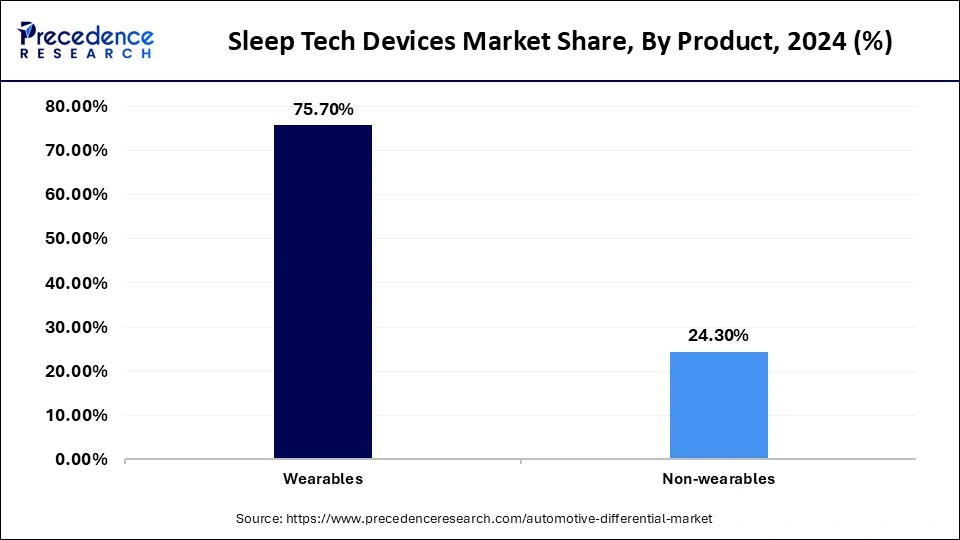
Besides, the non-wearables segment is expected to grow at a moderate rate over the projected period in the sleep tech devices market. These devices incorporate sensors into mattresses, mattress toppers, and bedding to monitor sleep patterns. They may provide insights into factors such as sleep duration, heart rate, and body movement, offering a non-intrusive alternative to wearables. When compared to wearable sleep monitors, non-wearable ones are more understated, practical, and usually don't need to be charged. Non-wearable trackers, however, could not offer as thorough of a sleep pattern analysis as wearable trackers, depending on the type or brand.
Application Insights
The insomnia segment held the dominating market share of 47.9% in 2024.The segment is observed to sustain the position during the forecast period. The segment expansion is attributed to the growing prevalence of insomnia. For instance, according to the American Sleep Association:
- A sleep issue affects around 70 million people in the US.
- The most prevalent sleep issue is insomnia, which affects 30% of individuals on a short-term basis.
- 10 % of the persons suffer from chronic sleeplessness.
- Nearly 40% of respondents say they've unintentionally nodded off during the day.
- Approximately 5% report falling asleep while driving.
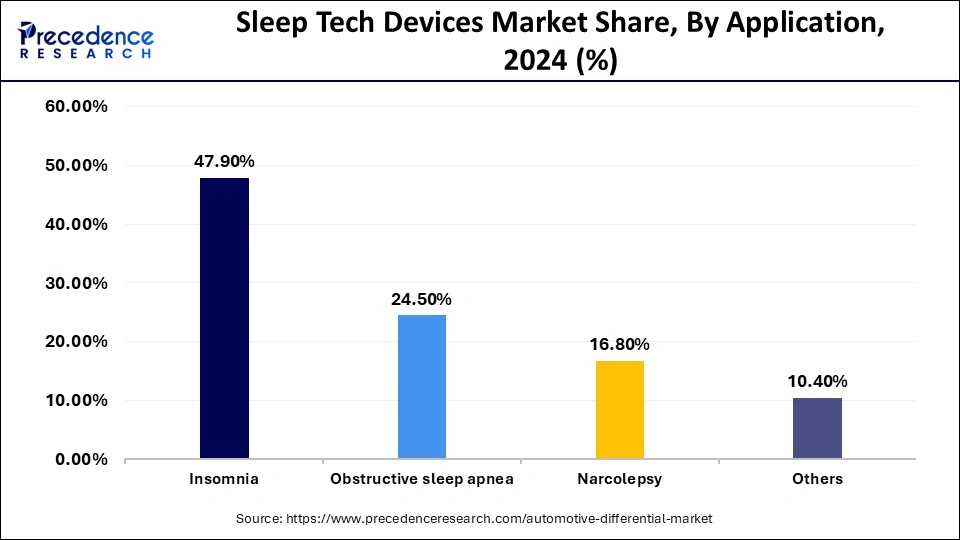
The obstructive sleep apnea is expected to grow at a significant rate over the projected period. Obstructive sleep apnea (OSA) is a common sleep disorder characterized by repeated episodes of partial or complete blockage of the upper airway during sleep, leading to disrupted breathing.
The sleep tech devices market addresses the needs of individuals with obstructive sleep apnea through various technologies aimed at monitoring, diagnosing, and managing the condition. CPAP machines are among the most common and effective devices for managing obstructive sleep apnea. These devices deliver a continuous stream of air to keep the airway open, preventing interruptions in breathing during sleep.
Distribution Channel Insights
The sleep centers and fitness centers segment dominated the sleep tech devices market with the largest share in 2024. Sleep centers and fitness centers often use advanced sleep monitoring devices for diagnosing sleep disorders, including polysomnography (PSG) equipment that records multiple physiological parameters during sleep. These devices help healthcare professionals assess and diagnose conditions such as sleep apnea, insomnia, and restless legs syndrome. Additionally, some sleep centers and fitness centers provide patients with home sleep testing devices for monitoring sleep in a familiar environment. These devices may include portable monitoring equipment that measures specific physiological parameters to assist in diagnosing sleep disorders.
The e-commerce segment is expected to grow at the highest CAGR in the sleep tech devices market during the forecast period. E-commerce allows consumers to explore a diverse range of sleep tech devices, including sleep trackers, smart mattresses, white noise machines, CPAP machines, and other innovations. The variety of products available online caters to different preferences and needs. Moreover, online shoppers can easily compare features, prices, and customer reviews across various sleep tech devices. This facilitates a more informed decision-making process and allows consumers to find products that best suit their requirements.
Recent Developments
- In January 2024, the National Sleep Foundation (NSF) created the SleepTech Network, a new community platform for stakeholders in the sleep technology business. The news comes from the CES trade exhibition in Las Vegas, which shows the whole technology environment. NSF is located in Booth 8604 in Tech East's North Hall. The inaugural members of the SleepTech Network range from high-profile start-ups to Fortune Global 500 representatives, representing key segments such as consumer electronics, digital therapeutics, mobility, consumer home products, and sleep-monitoring AI software. Asleep, Pocket Kado, PureCare, Samsung Health, Variowell, and Waymo are among the companies that participate.
- In December 2022, ASLEEP, a sleep technology firm, announced that it would reveal the blueprint for an individually personalized sleep environment based on its unequaled AI-based sleep monitoring technology at CES 2023. ASLEEP offers a wide range of sleep-related services using AI technology that analyzes sleep phases based on breathing sounds. ASLEEP's technology can identify sleep phases in any setting by utilizing microphone-equipped devices such as smartphones, smart TVs, and speakers. ASLEEP's sleep detection technology provides the most accurate results without the need for wearable devices such as smartwatches. It detects REM sleep, non-REM sleep, and wake state with an average 15% higher accuracy than industry-leading smartwatches.
- In January 2023, Earable Neuroscience conducted a global launch ceremony for its FRENZ™ Brainband at CES 2023. During the occasion, the business talked about the breakthroughs behind the award-winning gadget, its potential to disrupt sleep technology, a special discount pricing, and its 88 Pioneer project. Earable Neuroscience, a deep tech firm creating scalable, human-centric solutions that improve everyday experiences, had a global launch event for the FRENZ™ Brainband at the 2023 Consumer Electric Show (CES 2023) on Jan 6, revealing the breakthroughs that power the award-winning gadget.
Sleep Tech Devices Market Companies
Segments Covered in the Report
By Product
- Wearables
- Non-wearables
By Application
- Obstructive Sleep Apnea
- Insomnia
- Narcolepsy
- Others
By Distribution Channel
- Hypermarkets and Supermarkets
- Sleep Centers and Fitness Centers
- Pharmacy and Retail Stores
- E-commerce
- Others
`By Geography
- North America
- Europe
- Asia-Pacific
- Latin America
- Middle East and Africa
For inquiries regarding discounts, bulk purchases, or customization requests, please contact us at sales@precedenceresearch.com
Frequently Asked Questions
Ask For Sample
No cookie-cutter, only authentic analysis – take the 1st step to become a Precedence Research client